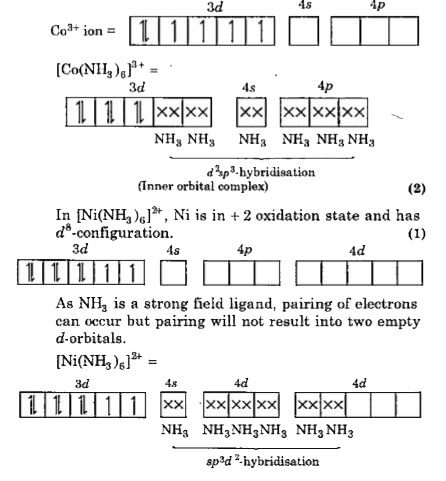Explain is an inner orbital complex, whereas is an outer orbital complex
In inner orbital complexes, (n-1) d-orbitals are used and in outer orbital complexes, nd-orbitals are used for hybridisation. In , Co is present as and has configuration. In the presence of strong field ligand , the 3d-electrons pair up leaving two d-orbitals empty to be involved in hybridisation forming inner orbital complex in the case of

Thus, (n-1) d-orbitals are not available but the nd-orbitals are used in bond formation, i.e. in hybridisation, the complex is called outer orbital complex.
Similar Questions
Knowledge Check
Assertion: Complex ion [Co(NH3)6]2+ is readily oxidized to [Co(NH3)6]3+
Reason: Unpaired electron in complex ion [Co(NH3)6]2+ is present in 4p orbital.AIf assertion is true but the reason is falseBIf assertion is false but reason is trueCIf both assertion and reason are true and the reason is the correct explanation of assertionDIf both assertion and reason are true but reason is not the correct explanation of assertionAssertion: Complex ion [Co(NH3)6]2+ is readily oxidized to [Co(NH3)6]3+
Reason: Unpaired electron in complex ion [Co(NH3)6]2+ is present in 4p orbital.AIf assertion is true but the reason is falseBIf assertion is false but reason is trueCIf both assertion and reason are true and the reason is the correct explanation of assertionDIf both assertion and reason are true but reason is not the correct explanation of assertion
[CoF6]3− forms outer orbital complexes while (Co(CN)6]3−forms inner orbital complexes. Why
View Solution[CoF6]3− forms outer orbital complexes while (Co(CN)6]3−forms inner orbital complexes. Why
View SolutionFor the complex ion of [Fe(CN)6]3− :
Is it an inner orbital complex or an outerorbital complex ?
View SolutionHow many of the following complexes are correctly matched with given properties ?
(a)[Ni(NH3)6]2+-Octahedral outer orbital complex and two unpaired electrons.
(b)[Cr(NH3)6]3+-Octahedral inner orbital complex and one unpaired electron.
( c)[Zn(NH3)6]2+-Octahedral outer orbital complex and diamagnetic.
(d)[Pt(NH3)4]2+-Square planar and diamagnetic
(e)[Co(SCN)4]2−-Tetrahedral and three unpaired electrons.
(f)[NiBr2(PPh3)2]-Square planar and diamagnetic.
View SolutionHow many of the following complexes are correctly matched with given properties ?
(a)[Ni(NH3)6]2+-Octahedral outer orbital complex and two unpaired electrons.
(b)[Cr(NH3)6]3+-Octahedral inner orbital complex and one unpaired electron.
( c)[Zn(NH3)6]2+-Octahedral outer orbital complex and diamagnetic.
(d)[Pt(NH3)4]2+-Square planar and diamagnetic
(e)[Co(SCN)4]2−-Tetrahedral and three unpaired electrons.
(f)[NiBr2(PPh3)2]-Square planar and diamagnetic.
View SolutionAssertion: Complex ion [Co(NH3)6]2+ is readily oxidized to [Co(NH3)6]3+
Reason: Unpaired electron in complex ion [Co(NH3)6]2+ is present in 4p orbital.
View Solution
